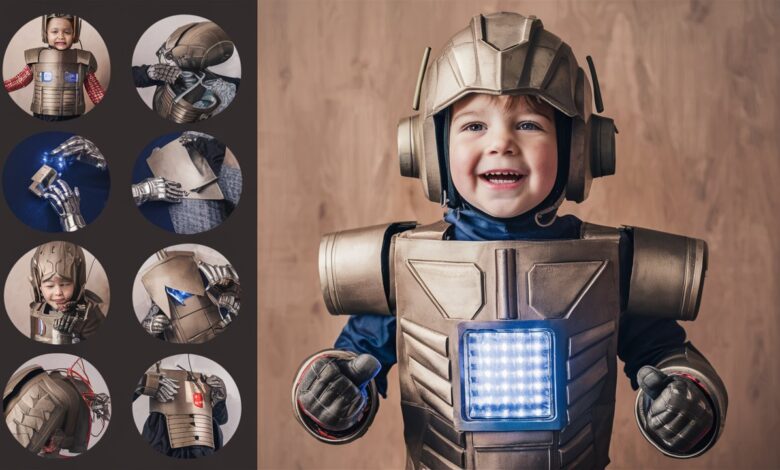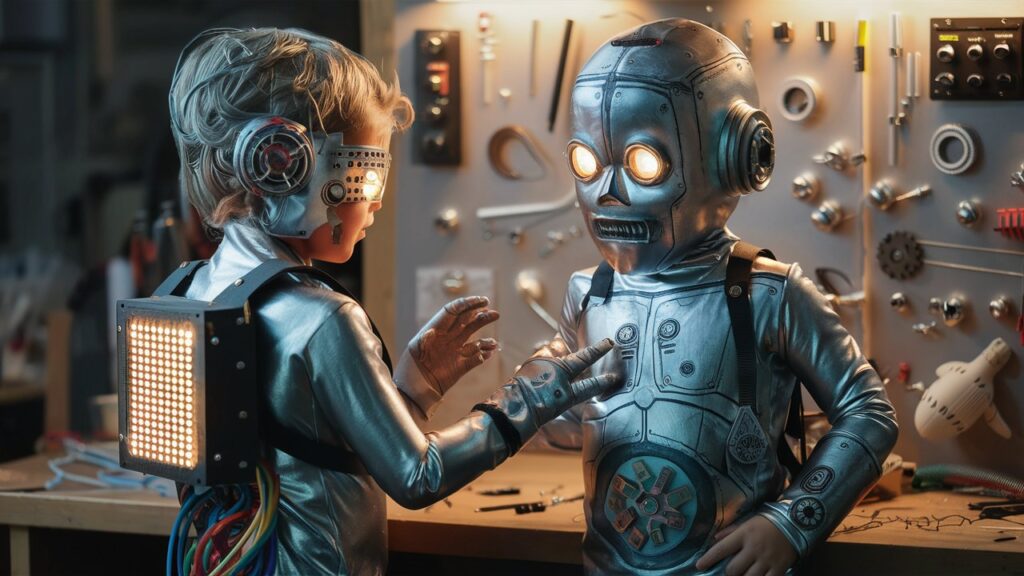Creating the Perfect Children’s Robot Costume: A Comprehensive Guide

Introduction
Robot costumes have long been a Halloween favorite, blending creativity with futuristic charm. Whether you’re crafting a DIY masterpiece or opting for a store-bought design, a robot costume offers endless opportunities for customization and imaginative play. This guide explores everything from materials and safety considerations to advanced tech features, ensuring your child’s costume is both dazzling and safe. Drawing insights from expert tutorials, safety guidelines, and innovative design ideas, we’ll help you build a robot outfit that sparks joy and stands out in the trick-or-treat crowd.
1. Designing a DIY Robot Costume: Step-by-Step Inspiration
Materials and Construction
The foundation of a DIY robot costume typically begins with cardboard boxes, which serve as the body and headpiece. Websites like Goodnight Fox and Days With Grey recommend using sturdy boxes, cutting arm and head holes for comfort, and reinforcing edges with tape to prevent wear 212. Aluminum ducting or flexible plastic tubing can create articulated arms and legs, while glow-in-the-dark fidget tubes or LED string lights add a futuristic glow 27. For a personalized touch, incorporate household items like bottle caps, old tiles, or LEGO bricks to mimic control panels or decorative rivets 12.
Adding Personality
Faceplates and antennae are key to the robot’s character. A wooden frame painted in bright colors or adorned with glow-in-the-dark googly eyes can serve as a faceplate, while ping-pong balls or yogurt cups transformed into light-up antennae add whimsy 27. The Instructables guide even suggests integrating sound effects using Arduino microcontrollers, allowing the costume to play pre-recorded phrases or respond to candy deposits with robotic noises 7.
2. Safety First: Ensuring a Secure and Comfortable Costume
Visibility and Mobility
A common pitfall of robot costumes is restricted vision or movement. The U.S. CPSC and Safe Kids Worldwide emphasize avoiding masks that obstruct sight, opting instead for face paint or well-ventilated faceplates 414. Costumes should fit snugly to prevent tripping, with reflective tape or glow sticks enhancing visibility after dark 914. For DIY designs, ensure arm and leg attachments (like aluminum ducting) are lightweight and allow free movement 27.
Flame Resistance and Materials
Store-bought costumes must meet flame-resistant standards, but DIY creators should prioritize synthetic fabrics like nylon or polyester, which are inherently less flammable 4. Avoid loose, billowy fabrics near open flames (e.g., jack-o’-lantern candles), and use battery-operated lights instead 914.
3. Tech Enhancements: Elevating the Robot Experience
Interactive Features
For tech-savvy families, integrating electronics can transform a basic costume into an interactive marvel. The Instructables tutorial details adding pressure sensors to boots for “robotic” footsteps, a candy detector with infrared beams, and a button pad linked to sound modules 7. Battery-powered LED strips or Arduino-controlled lights in antennae or ears create a mesmerizing effect, while voice changers can modulate your child’s speech for added authenticity 7.
Practical Considerations
Keep wiring and batteries secure. Waterproof enclosures (like Tupperware) protect electronics from rain, and foam padding prevents components from shifting during wear 7. Always test tech features beforehand to avoid malfunctions mid-trick-or-treat!
4. Store-Bought vs. DIY: Weighing the Options
Retail Robot Costumes
Retailers like HalloweenCostumes.com and Walmart offer pre-made designs ranging from retro silver suits to Futurama-inspired Bender outfits 1011. These options save time and often include built-in accessories like helmets or light-up details. However, they may lack customization and durability compared to DIY versions.

The DIY Advantage
Handmade costumes foster creativity and can be tailored to a child’s interests—think a “space explorer” robot with galaxy-themed decals or a “helper bot” with toolbelt accessories. Involving kids in the design process also builds ownership and pride 12.
5. Maintenance and Longevity: Keeping the Costume Fresh
Post-Halloween Care
Cardboard costumes may not last beyond one season, but components like LED lights or fabric panels can be reused. Store electronics in anti-static bags, and repair loose attachments with hot glue or Velcro. For store-bought suits, follow washing instructions to preserve flame-resistant coatings 49.
Repurposing for Play
Robot costumes aren’t just for Halloween! Add the outfit to a dress-up bin for year-round imaginative play, or modify it into a school project about technology or space exploration.
Conclusion
A children’s robot costume is more than just a Halloween outfit—it’s a gateway to creativity, STEM learning, and unforgettable memories. By blending safety precautions with inventive design, you can craft a costume that delights your child and withstands the excitement of trick-or-treating. Whether you choose a DIY approach or a store-bought kit, prioritize comfort, visibility, and a dash of futuristic flair.
Frequently Asked Questions
Q: How can I make a robot costume safe for nighttime trick-or-treating?
A: Use reflective tape on the costume and treat bag, attach LED string lights, and ensure the child carries a flashlight. Avoid masks that block vision 914.
Q: What materials are best for a DIY robot costume?
A: Cardboard boxes, aluminum ducting, and synthetic fabrics (nylon/polyester) are durable and flame-resistant. Decorate with glow-in-the-dark paint or battery-operated lights 24.
Q: Can I add electronics to a store-bought costume?
A: Yes! Attach adhesive LED strips or clip-on sound modules to enhance pre-made designs. Ensure batteries are securely enclosed 710.
Q: How do I prevent the costume from being too heavy?
A: Use lightweight materials like foam board instead of metal, and limit bulky attachments. Ensure the headpiece is supported by the torso, not the neck 212.
Q: Are there allergy-friendly alternatives to candy for a robot-themed trick-or-treat setup?
A: Offer non-edible treats like glow sticks, stickers, or small toys, and participate in the Teal Pumpkin Project to signal allergy-safe options 9.
By merging practicality with imagination, your child’s robot costume will be the highlight of Halloween—and maybe even inspire a lifelong love of robotics!



